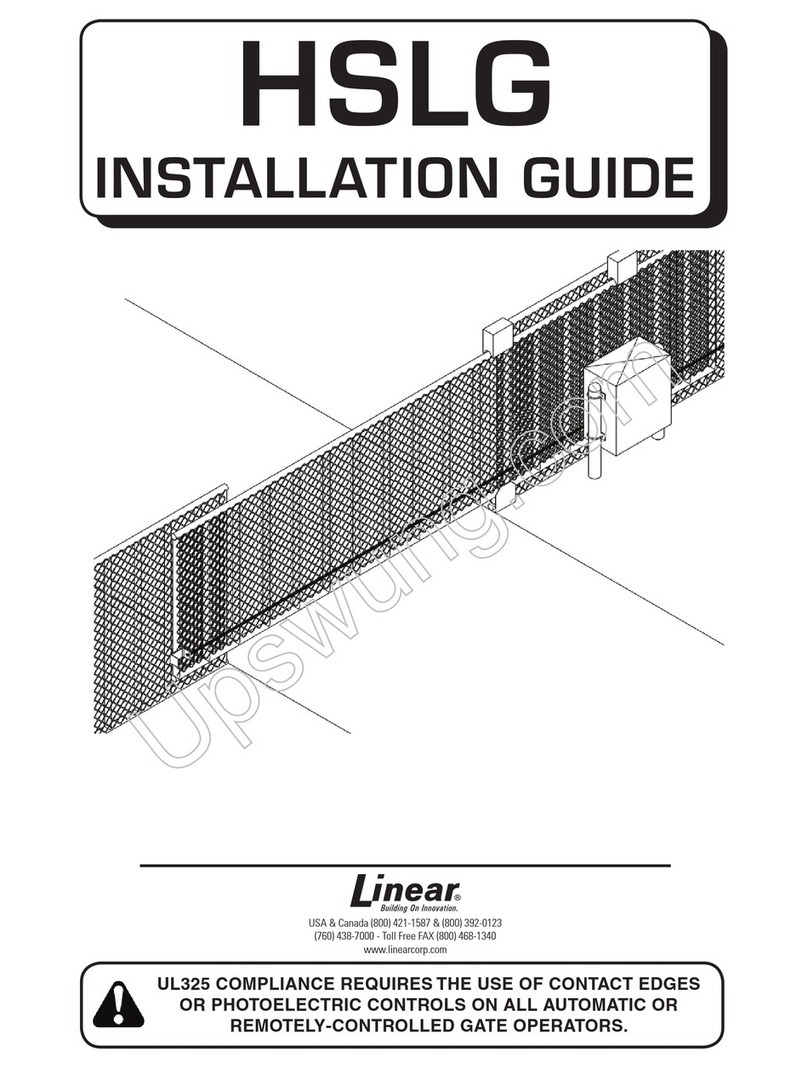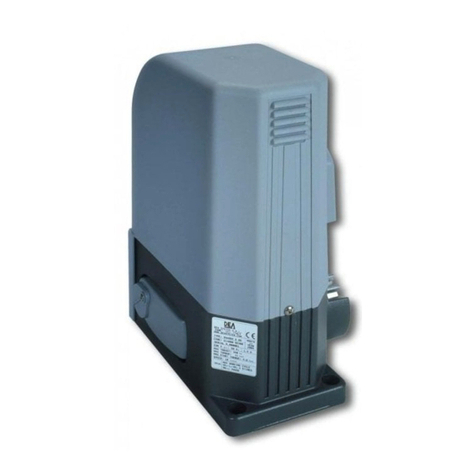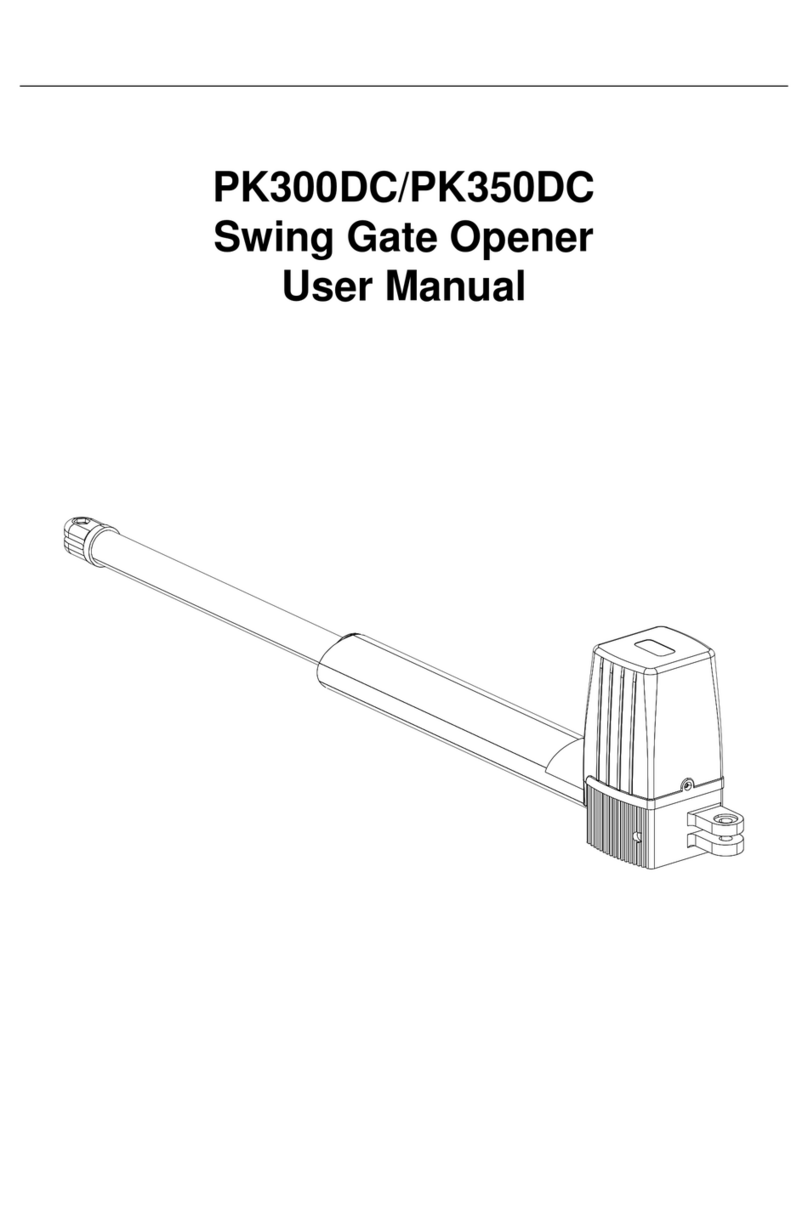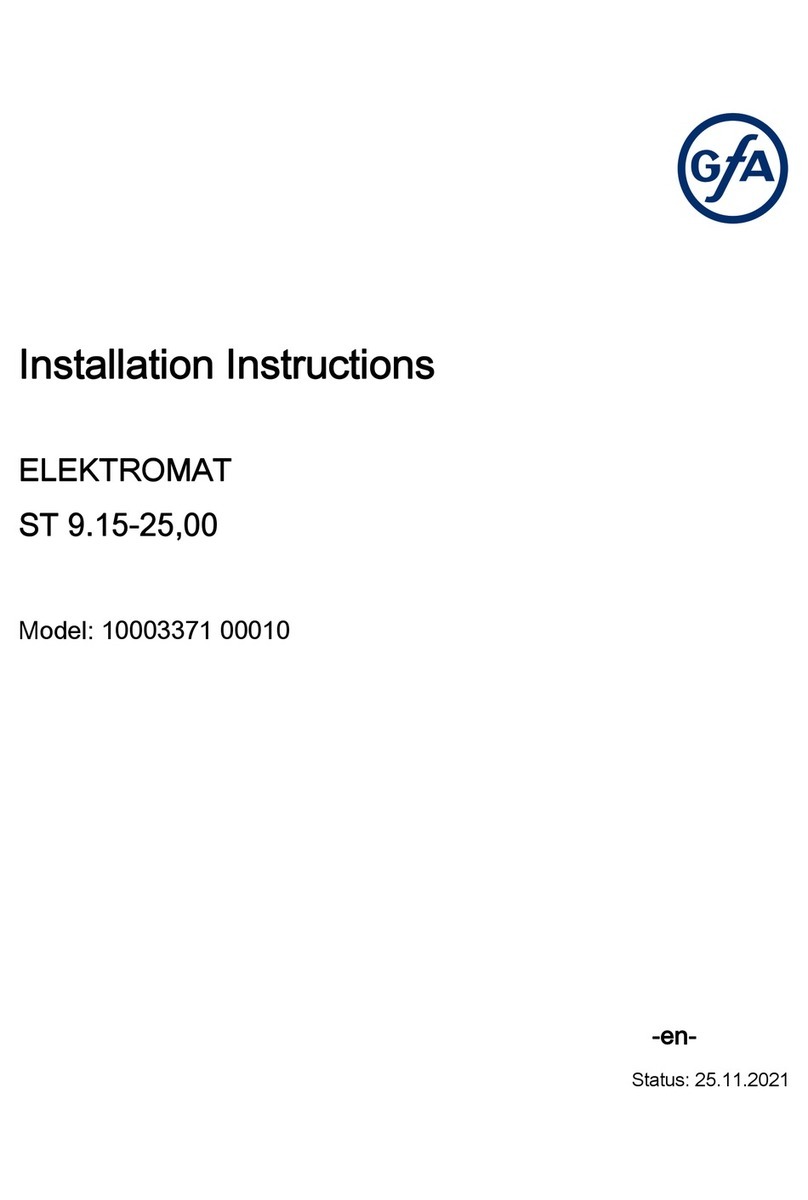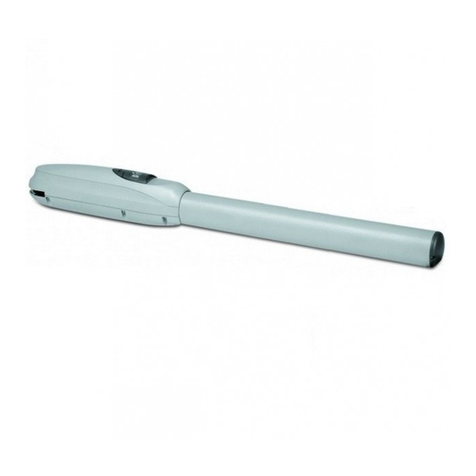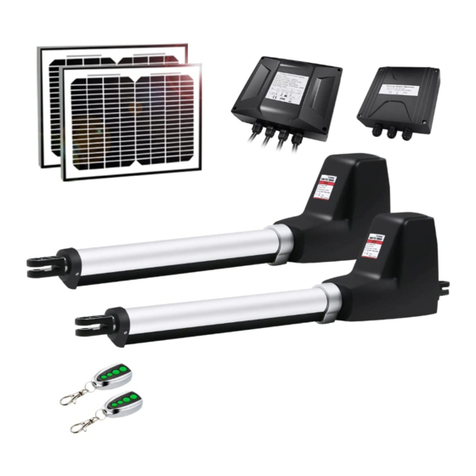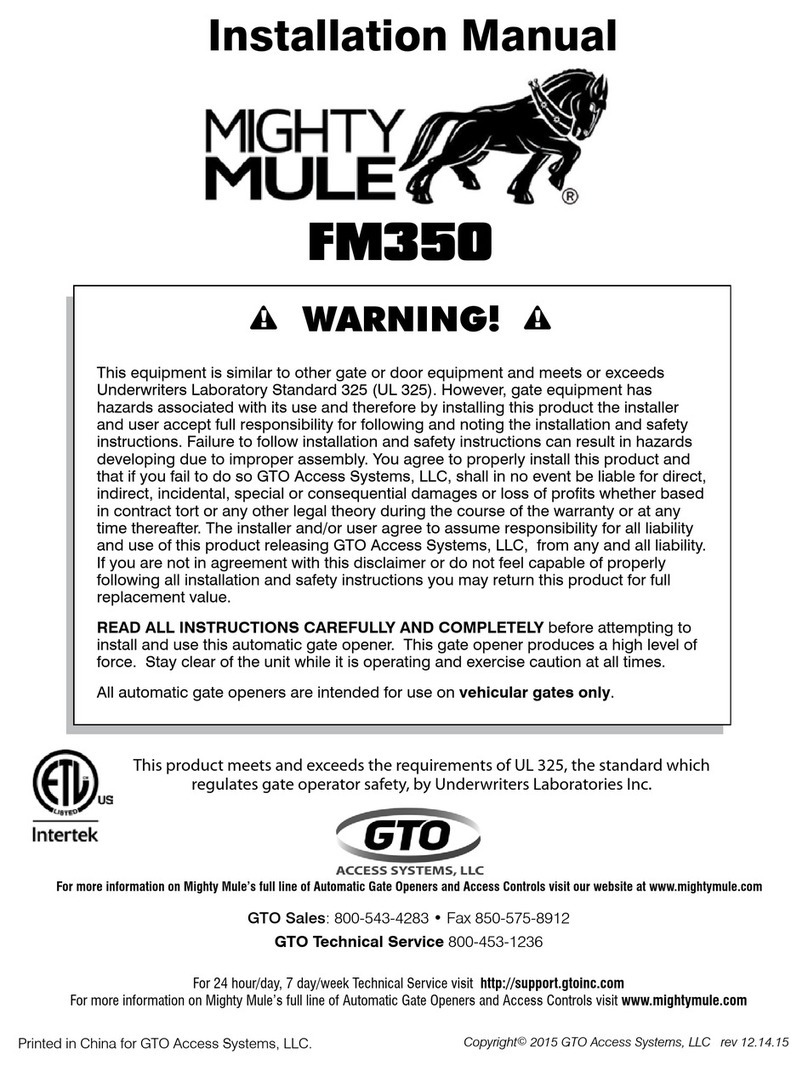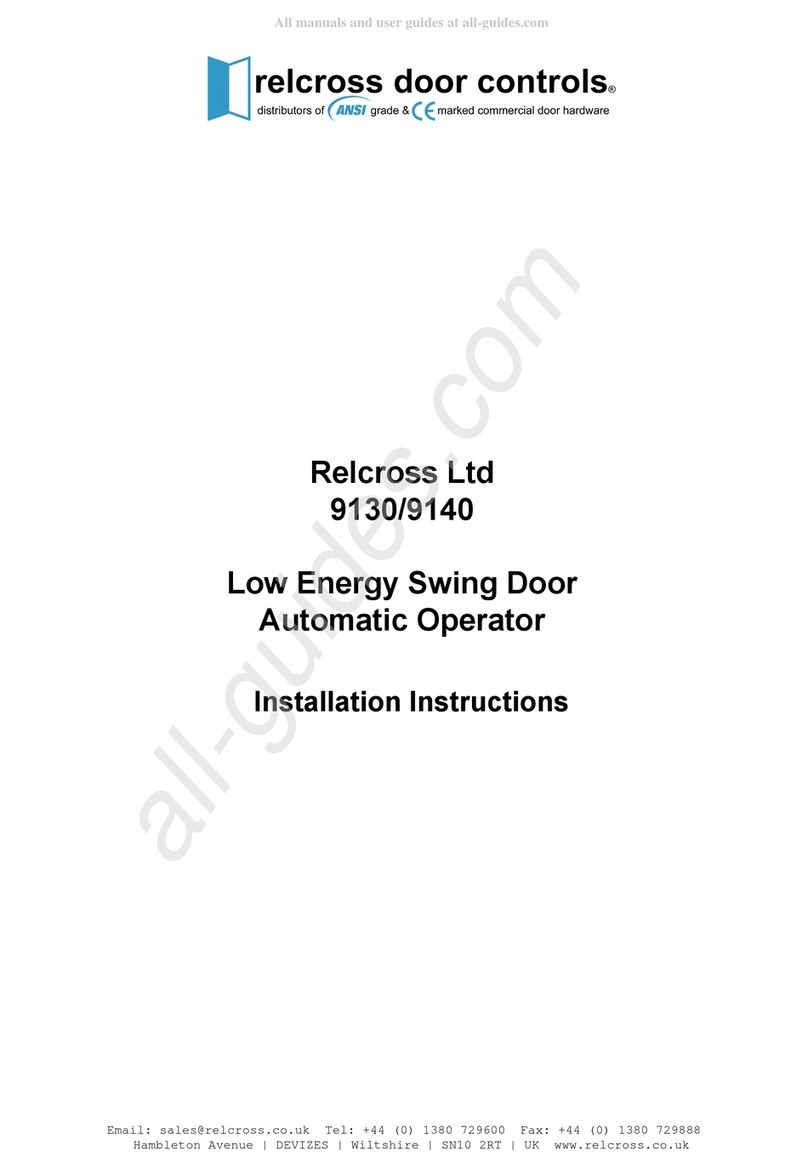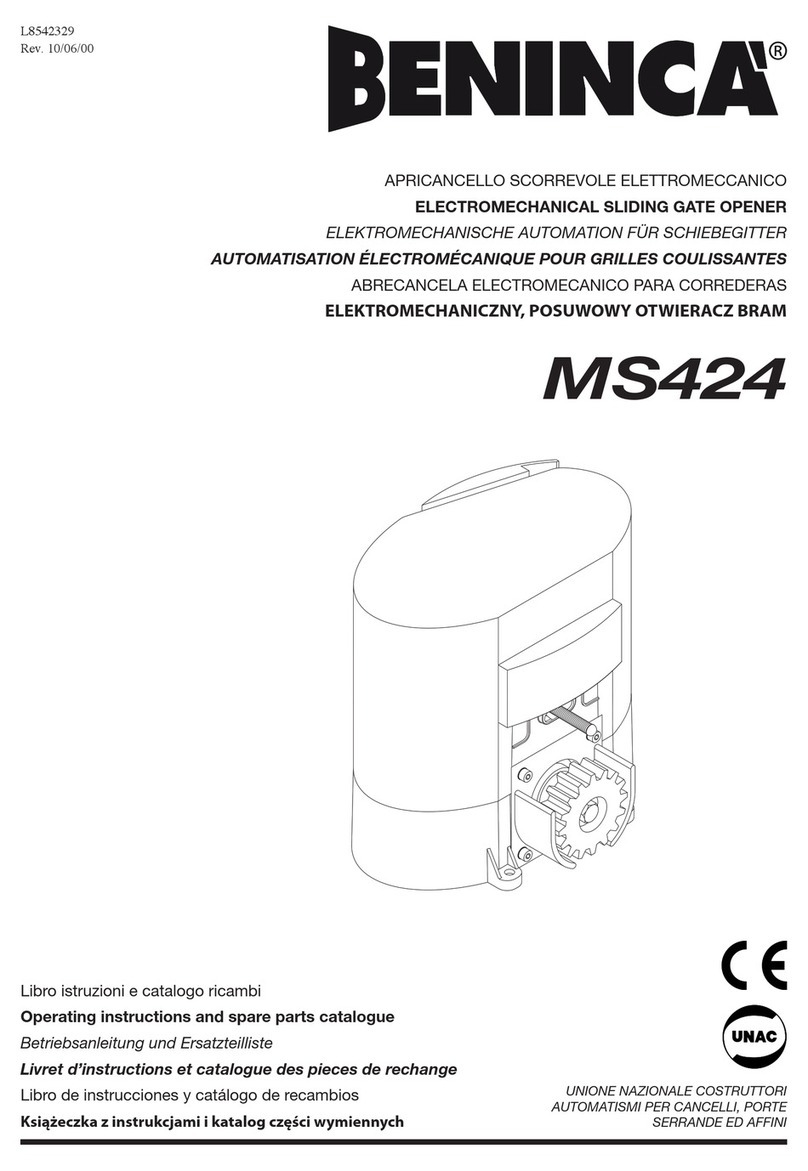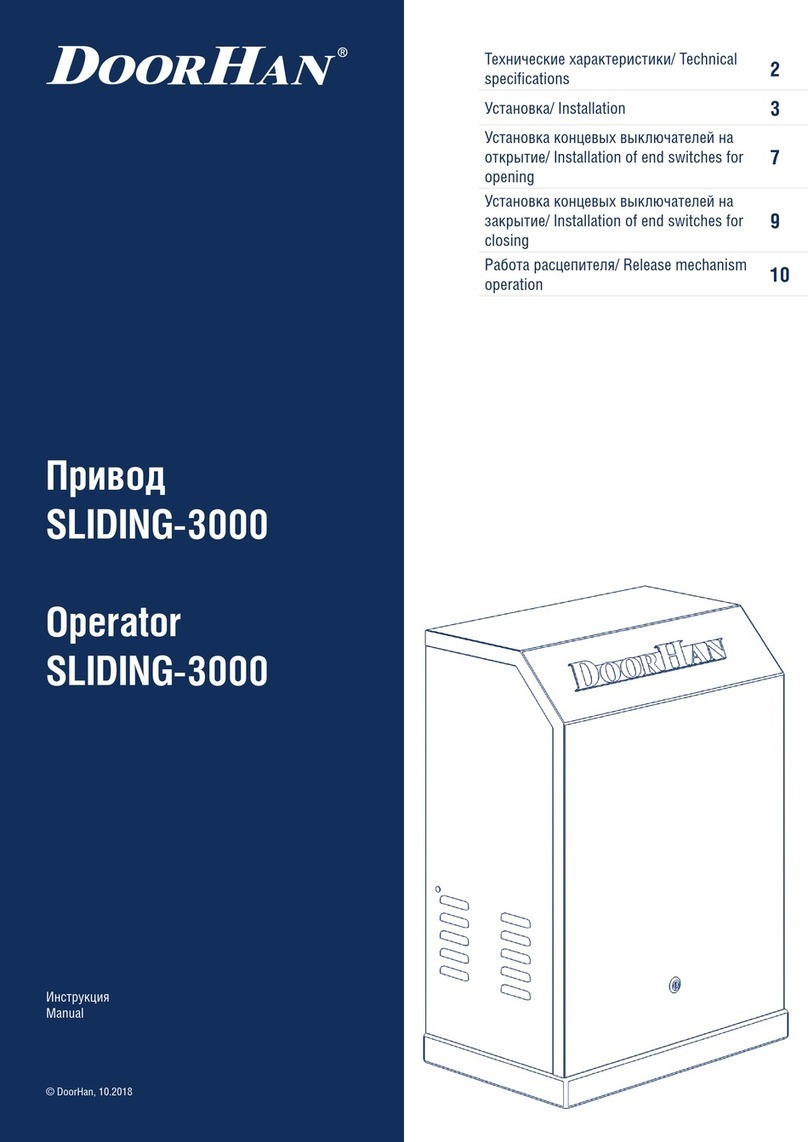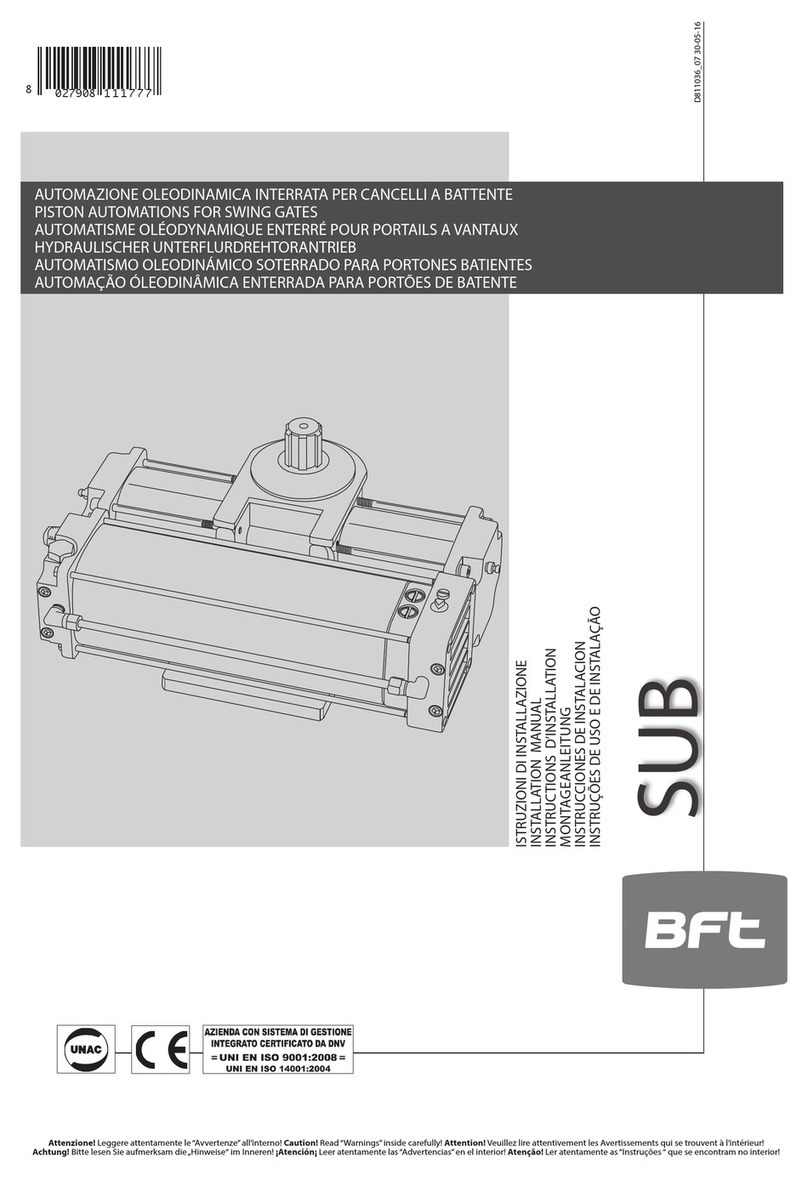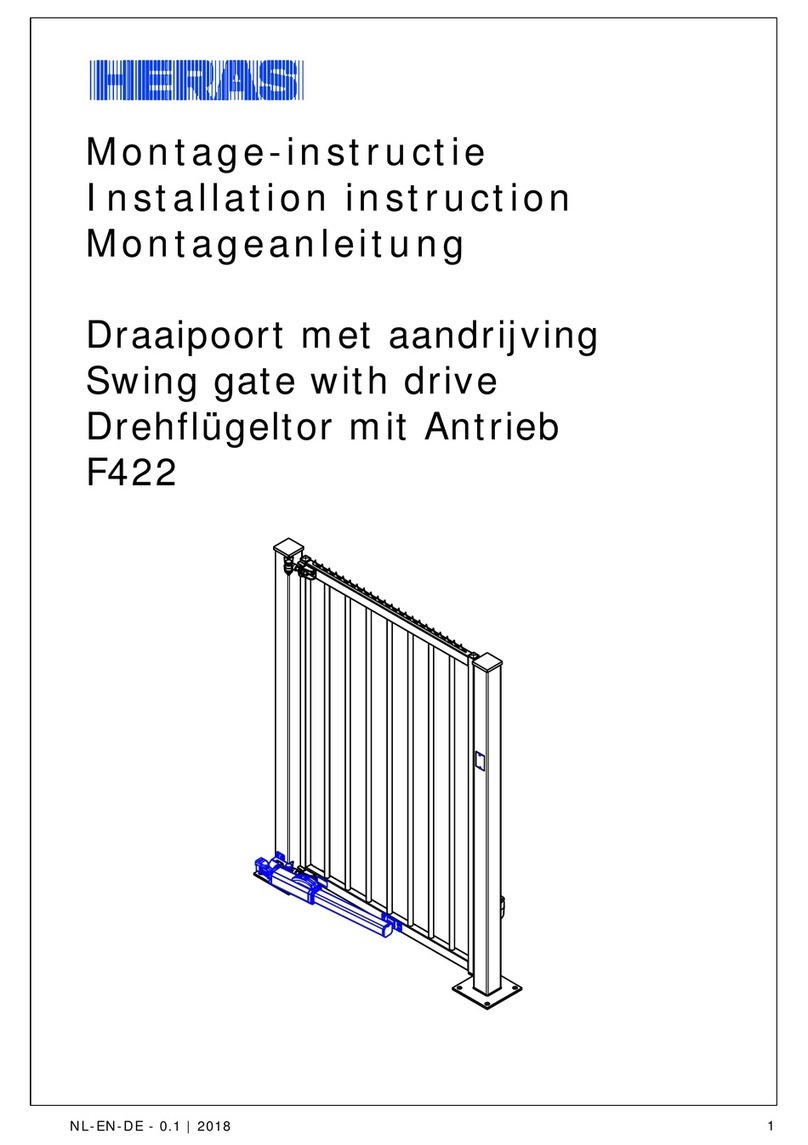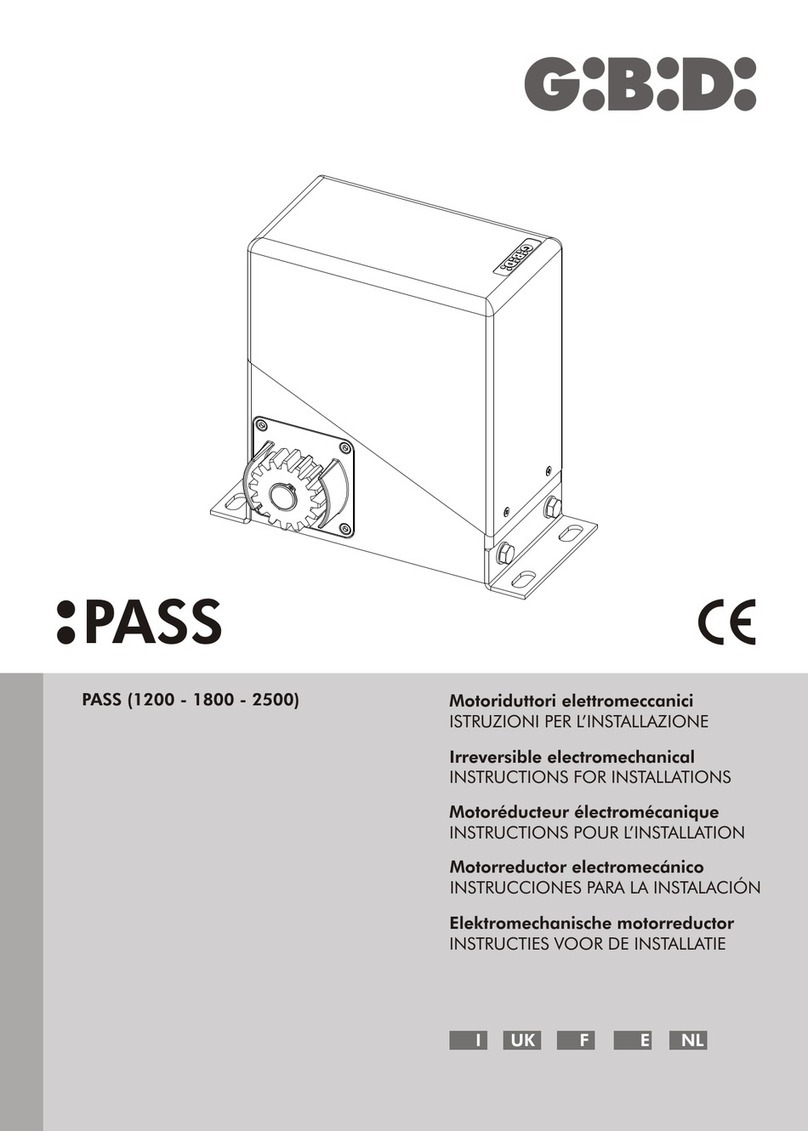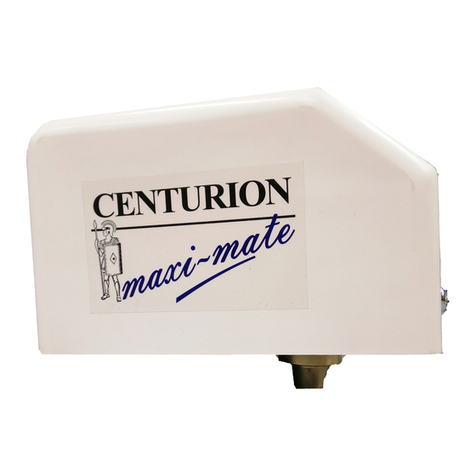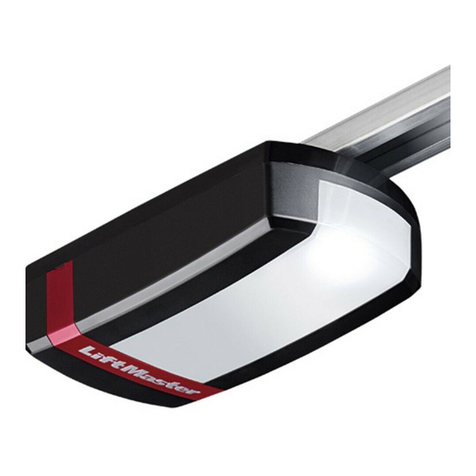Linear VS-GSLG User manual

VS-GSLG
INSTALLATION GUIDE
UL325 COMPLIANCE REQUIRES THE USE OF CONTACT EDGES
OR PHOTOELECTRIC CONTROLS ON ALL AUTOMATIC OR
REMOTELY-CONTROLLED GATE OPERATORS.
USA & Canada (800) 421-1587 & (800) 392-0123
(760) 438-7000 - Toll Free FAX (800) 468-1340
www.linearcorp.com

VS-GSLG OPERATOR INSTALLATION GUIDE
- 2 -
TABLE OF CONTENTS
PRE-INSTALLATION INFORMATION
Gate Operator Classifications........................................................................................................................................................................................................ 3
Safety Information and Warnings................................................................................................................................................................................................... 3
Pre-Installation Information............................................................................................................................................................................................................ 3
INSTALLATION
Unpacking and Inspection ............................................................................................................................................................................................................. 4
Pre-Installation Information............................................................................................................................................................................................................ 4
Installation Instructions .................................................................................................................................................................................................................. 4
Electrical Instructions and LImit Switch Adjustments .................................................................................................................................................................... 5
Installation Instructions Drawing.................................................................................................................................................................................................... 6
Four Switch Rotary Limit Box Photo.............................................................................................................................................................................................. 7
Torque Limiter Adjustment............................................................................................................................................................................................................. 8
Manual Disconnect ........................................................................................................................................................................................................................ 8
Maintenance .................................................................................................................................................................................................................................. 9
CONTROL BOARD ADJUSTMENTS and ACCESSORY CONNECTIONS
Control Board Adjustments.......................................................................................................................................................................................................... 10
Terminal Connection Descriptions............................................................................................................................................................................................... 11
Current Sensing Adjustments...................................................................................................................................................................................................... 12
Close Direction Current Sense Adjustment ................................................................................................................................................................................. 12
Open Direction Current Sense Adjustment.................................................................................................................................................................................. 12
Maximum Run Timer Adjustment................................................................................................................................................................................................. 12
Auto Close Timer Adjustment ...................................................................................................................................................................................................... 12
Master/Slave Connection............................................................................................................................................................................................................. 12
Onboard L.E.D. Indicator Descriptions......................................................................................................................................................................................... 13
Important Notes for Installation of Master/Slave Applications ..................................................................................................................................................... 14
Surge Protector Instructions ........................................................................................................................................................................................................ 14
Control and Accessory Connection Illustrations .....................................................................................................................................................................15-18
ILLUSTRATIONS
Loop Layout Illustration................................................................................................................................................................................................................ 19
Edge Layout Illustration #1 .......................................................................................................................................................................................................... 20
Edge Layout Illustration #2 .......................................................................................................................................................................................................... 21
Photo Eye Illustration................................................................................................................................................................................................................... 22
Picket Gate Illustration................................................................................................................................................................................................................. 23
Track Gate Illustration .................................................................................................................................................................................................................. 24
TROUBLESHOOTING ..................................................................................................................................................................................................................... 25
PARTS LISTS
How to Order Replacement Parts................................................................................................................................................................................................ 25
Model VS-GSLG Mechanical Parts Exploded View ..................................................................................................................................................................... 26
Model VS-GSLG Mechanical Parts List ....................................................................................................................................................................................... 27
Model VS-GSLG Control Box Exploded View and Parts List - AC Tech ...................................................................................................................................... 28
Programming Instructions for Variable Speed Drive - AC Tech.................................................................................................................................................... 29
Model VS-GSLG Control Box Exploded View and Parts List - Hitachi......................................................................................................................................... 30
Programming Instructions for Variable Speed Drive - Hitachi...................................................................................................................................................... 31
Wiring Specifications ................................................................................................................................................................................................................... 32
PREVENTATIVE MAINTENANCE ................................................................................................................................................................................................... 34
GATE OPERATOR INSTALLATION CHECKLIST ........................................................................................................................................................................... 36
CAUTION!
DO NOT INSTALL
CONTROLS ON A
GATE OR FENCE LINE
CAUTION!
ONLY QUALIFIED SERVICE
TECHNICIANS SHOULD
WORK ON A LINEAR
SLIDE GATE OPERATOR
CAUTION!
DO NOT INSTALL
CONTROLS
ON THE OPERATOR

VS-GSLG OPERATOR INSTALLATION GUIDE
- 3 -
Read the following before beginning to install Linear slide
gate operators:
1. Read the yellow “Safety Instructions” brochure enclosed
with the packet of information. If you do not have one,
please call Linear at 1-800-333-1717 to request one.
Read and follow all instructions.
2. All electrical connections to the power supply must be
made by a licensed electrician and must observe all
national and local electrical codes.
3. A separate power-disconnect switch should be located
near the operator so that primary power can be turned
off when necessary.
4. A minimum of two (2) WARNING SIGNS shall be in-
stalled, one on each side of the gate where easily vis-
ible.
5. Never reach between, through or around the fence to
operate the gate.
6. You must install all required safety equipment.
GATE OPERATOR
CLASSIFICATIONS
PRE-INSTALLATION INFORMATION
Before unpacking, inspect the carton for exterior damage. If
you find damage, advise the delivery carrier of a potential
claim.
Inspect your package carefully.You can check your accessory
box parts with the enclosed packing slip for your convenience.
Claims for shortages will be honored for only 30 days from
the date of shipment.
Before installing the operator, read this manual completely
to ensure all requirements for proper installation are pres-
ent. Verify that the voltage to be used matches the voltage
of the operator.
SAFETY INFORMATION
AND WARNINGS
IMPORTANT!!
Before installing the gate operator, make sure the gate’s slide
is free and level throughout the entire opening distance. If
the gate does not seem to operate properly, it may affect the
operator performance or greatly shorten the life of the unit.
The gate should be designed so that airflow through the fabric
is ample to prevent wind resistance and drag.
All gate operators can be divided into one of four different
classifications, depending on their design and usage.
Class I: Residential
A vehicle gate operator (or system) intended for use in a
home of one to four single-family dwellings, or a garage or
parking area associated therewith.
Class II: Commercial or General Public Access
A vehicular gate operator (or system) intended for use in
a commercial location or building such as a multi-family
housing unit (five or more single-family units), hotel, garage,
retail store, or other building servicing the general public.
Class III: Industrial or Limited Access
A vehicular gate operator (or system) intended for use in
an industrial location or building such as a factory or load-
ing dock area or other locations not intended to service
the general public.
Class IV: Restricted Access
A vehicular gate operator (or system) intended for use in
a guarded industrial location or building such as an airport
security area or other restricted access locations not ser-
vicing the general public, in which unauthorized access is
prevented via supervision by security personnel.
Model VS-GSLG is intended for Class III and IV applications
only.
The following contact or non-contact obstruction
detection devices have been approved for use
with Linear slide gate operators as part of a UL325
compliant installation:
Contact Edges:
Miller Models*: MG0-20, MGR-20, MGS-20, and
ME-120
Photoeyes:
2520-441 MMTC Model IR-55 photoeye, 165’ with
mounting hardware
2520-031 MMTC Model E3K photoeye, 28’ with
mounting hardware
*for Linear part numbers, contact a sales representative for details

VS-GSLG OPERATOR INSTALLATION GUIDE
- 4 -
UNPACKING AND INSPECTION
Before unpacking check the carton for exterior damage. If you find damage advise the deliverer of a potential claim.
If any of the following parts are missing from the carton, immediately notify your supplier. Claims for shortages will be honored
for only 30 days from the date of shipment:
(1) VS-GSLG Operator (1) Hardware Bag Containing:
(1) Chain in Box (2) #50 Master Link
(1) Hardware Box Containing: (16) 3/8” Hex Nuts
(2) Gate Brackets (16) 3/8” Lock Washers
(4) 3” U-Bolts (16) 3/8” Flat Washers
(4) 4” U-Bolts (2) Springs (heavy)
(2) 3/16” Side Plates (4) 1/2” Hex Nuts
(2) 1/2” Side Plates (2) 1/2” Flat Washers
(2) 1/2” Chain Bolts (4) 3/8”-16 x 3/4” Square Head Set Screw
PRE-INSTALLATION INFORMATION
Before installing the VS-GSLG, read this manual completely to ensure all requirements for proper installation are present.
Verify that the voltage to be used matches the voltage of the operator.
IMPORTANT: The gate must operate properly to assure trouble-free installation. Before installing the gate operator to the
gate, make sure the gate’s slide is free and unobstructed. If the gate doesn’t seem to operate properly, it
may affect the operator performance or greatly shorten the life of the unit.
INSTALLATION INSTRUCTIONS
NOTE: These instructions are for an operator on the right side of the opening, when viewed from the inside looking out.
Left-hand installation is simply transposed.
LOCATING AND INSTALLING POSTS
Locate and secure two galvanized posts (3” ID, 3 1/2” OD; see
drawing #2700-152). Embed the posts in concrete to a depth
required by local code or below the frost line.
OPERATOR INSTALLATION
Attach the operator to the posts using the U-Bolts and side
plates provided (see drawing #2700-223).The operator can be
adjusted vertically to suit; 12” to 18” from the bottom of the idler
sprockets (chain line) would be normal. See drawing #2700-152
for additional installation information.
CHAIN BRACKET INSTALLATION
Slide the gate to the fully closed position. Secure the chain
bracket on the vertical post of the back frame with the chain
bolt level with the bottom of the idler sprockets.
Slide the gate to the fully open position and secure the front
chain bracket on the front vertical post of the gate. Once again,
the chain bolt hole should be level with the bottom of the idler
sprockets.
The operator is intended for installation only on
gates used for vehicles. Pedestrians must be sup-
plied with a separate access opening. The pedestrian
access opening shall be designed to promote pedes-
trian usage. Locate the gate such that persons will
not come in contact with the vehicular gate during
the entire path of travel of the vehicular gate.
Drawing #2700-223

VS-GSLG OPERATOR INSTALLATION GUIDE
- 5 -
IMPORTANT
A. Power supply must be of correct voltage and phase.
B. Always disconnect power from operator before servicing.
C. Keep clear of gate during operation.
ELECTRICAL INSTRUCTIONS
You’ll find the complete electrical circuit print inside the operator cover. The power supply must be ample and not taken from
an overloaded line, as faulty operation will result. The supply must be of correct voltage and phase. For proper wire gauge,
refer to “Wiring Specifications” on Page 32.
Proper thermal protection is supplied with the operator. The motor contains a thermal overload protector (single phase) to
protect from overheating the motor due to overload or high-frequency operation.
LIMIT SWITCH ADJUSTMENT
(For Right Hand Operation, Left Hand Opposite)
Refer to the photo on page 7 when following these instructions.
Adjust the limit nuts by depressing the detent plate and turning the nuts in the desired direction of travel. To allow for addi-
tional travel in the open direction, for instance, rotate the open limit nut so that it moves to the left on the shaft. To allow for
greater travel in the close direction, rotate the close limit nut so that it moves to the right on the shaft.
Special Notes for Setting Speeds using LSO-2 & LSC-2:
Limit switches LSO-2 and LSC-2 control when the operator accelerates to maximum speed and decelerates to minimum
speed. It is recommended that LSO-2 and LSC-2 are adjusted first* so the gate slows to near stop before hitting LSO-1 or
LSC-1 as these will apply the brake upon activation.
* These are adjusted by slightly loosening the two screws which hold them in place and sliding toward or away from the center
of the limit box. Care must be taken not to adjust too close to the center as the limit nut may travel past the switch and start
accelerating at the end of the cycle.

VS-GSLG OPERATOR INSTALLATION GUIDE
- 6 -

VS-GSLG OPERATOR INSTALLATION GUIDE
- 7 -
PICTURE OF FOUR SWITCH ROTARY LIMIT BOX
2520-453
ON RIGHT HAND,
LSC-2
ON LEFT HAND, LSO-2
ON RIGHT HAND,
LSO-2
ON LEFT HAND, LSC-2
ON RIGHT HAND,
LSC-1
ON LEFT HAND, LSO-1
ON RIGHT HAND,
CLOSE LIMIT NUT
ON LEFT HAND,
OPEN LIMIT NUT
ON RIGHT HAND
OPEN LIMIT NUT
ON LEFT HAND,
CLOSE LIMIT NUT
ON RIGHT HAND,
LSO-1
ON LEFT HAND, LSC-1
DETENT PLATE
REMOVE CARDBOARD BEFORE AD-
JUSTING OR RUNNING OPERATOR!!
LSO-1 AND LSC-1 CONTROL
GATE FULL OPEN AND CLOSE
LSO-2 AND LSC-2 CONTROL
GATE OPERATOR RAMP UP AND
DOWN (SEE PAGE 5)

VS-GSLG OPERATOR INSTALLATION GUIDE
- 8 -
CHAIN SUPPORTS
When necessary, due to the length of the gate and chain, chain supports should be added to the gate at equally spaced
distances to allow the chain to sag as little as possible. A bolt located one inch below the chain line should be adequate.
MANUAL DISCONNECT
Use the mechanical parts exploded view drawing on page 26 and mechanical parts list on page 27 to locate the shifter lever
and the locking lever on the VS-GSLG operator. They can be found at the center and to the left inside the operator cabinet.
(The handle of each has been finished in easy to spot red firm-grip coating.)
To disconnect the unit for manual operation, grasp the handle of the spring-loaded shifter lever and pull it directly toward you
until the spring-loaded locking lever snaps into place behind it.This action disengages the pinned shifter block from the drive
mechanism and holds the block in the disengaged position.
To re-engage the operator, move the locking lever to the right, releasing the spring-loaded shifter lever to snap back into the
engaged position.
TORQUE LIMITER ADJUSTMENT
Before adjusting the torque limiter, make sure the gate is in good working condition. One person should be able to move the
gate by hand. Be certain the gate moves freely and without binding throughout its entire travel.
The torque limiter is set light at the factory. It must be adjusted during installation and checked on a regular basis.
NOTE: The torque limiter should be set tight enough so that when the operator starts the torque limiter does not slip, but
loose enough to slip if the gate is obstructed.
TURN OFF POWER TO THE
OPERATOR BEFORE
MAKING ADJUSTMENTS!
1. Loosen the set screw on the the adjustment nut.
2. To increase the output, turn the adjustment nut clock-
wise one flat, or 1/6 turn, at a time until desired output
is obtained.
WARNING: Do not overtighten. The torque limiter must
slip if the gate is obstructed.
To reduce the output, turn the adjustment nut coun-
terclockwise one fIat, or 1/6 turn, at a time until desired
output is obtained.
NOTE: A properly adjusted torque limiter will not slip
during normal operation.
3. Retighten the set screw on the adjustment nut.
ADJUSTMENT NUT
SET SCREW

VS-GSLG OPERATOR INSTALLATION GUIDE
- 9 -
MAINTENANCE
IMPORTANT
A. Power supply must be of correct voltage and phase.
B. Always disconnect power from operator before servicing.
C. Keep clear of gate during operation.
GENERAL
Linear gate operators are designed for many years of trouble-free operation and, under normal operating conditions, will
require only minimal maintenance.
To ensure that your unit is ready for operation at all times — and to preclude serious damage or failure — inspect the unit
systematically. Proper adjustments and lubrication should be made as recommended.
LUBRICATION
BEARINGS.Pillow block bearings are equipped with fittings and should be lubricated twice each year.
MOTOR. Motors have sealed ball bearings and do not require further lubrication. If bearing noise develops after several
years of operation, bearings should be replaced.
DRIVE CHAIN AND SPROCKET. The main drive chain and sprockets should be inspected, cleaned, and lightly oiled every
six months. Do not oil chains inside the operator.
12-MONTH PREVENTATIVE MAINTENANCE
1. Check clutch for correct tension every 12 months.
2. Inspect clutch disc for wear every 12 months.
3. Check limit switches for adjustment and wear.
4. See that all nuts and bolts are tight.
5. Check oil level in gear reducer every 12 months. Fill
up with #90/140 oil.
6. Check chain tension of main drive chain every 6
months. Chain must be taut (not overly tight).
7. Clean and lubricate main drive chain and sprockets
every 6 months using 40W oil. Do not use heavy
grease in cold climates.
DISCONNECT POWER FROM THE
OPERATOR BEFORE SERVICING!!!

VS-GSLG OPERATOR INSTALLATION GUIDE
- 10 -
Auto Close Timer Adjustment: This 270-degree adjustable potentiometer will signal the operator to close automatically,
provided no open, reversing or obstruction signals are present from the fully-open position. This timer is adjustable from 0
to 124 seconds. This feature is turned on or off using dip switch #1.
Maximum Run Timer Adjustment: This 270-degree adjustable potentiometer will signal the operator to stop running once
it counts down, unless a limit switch is reached or an input is received first. Each time the motor starts, this timer will begin
counting. This timer is adjustable from 15 to 100 seconds. If the timer expires, the unit locks out and the emergency alarm
sounds.
Open Direction Current Sense Adjustment: This multi-turn potentiometer is used to calibrate the built-in current sensing
feature for detection of obstructions while running in the open direction.
Close Direction Current Sense Adjustment: This multi-turn potentiometer is used to calibrate the built-in current sensing
feature for detection of obstructions while running in the closed direction.
Master/Slave Connection Block: This terminal block is used in conjunction with two operators to configure two gates to
open and close together.
Dip Switches:
#1 This switch turns the auto close timer off/on.
#2 This switch is used in conjunction with alarms and flashing lights that may be added to the operator. When the switch
is in the ON position, these devices will start approximately two seconds prior to the operator starting. In the OFF
position, the devices will only work while the operator is running.
#3 This switch is used in conjunction with single-button controls and radio receivers. In the ON position, successive inputs
will cause signals in the order of OPEN-STOP-CLOSE-STOP. In the OFF position, inputs will cause an OPEN signal
unless the gate is fully open, in which case it will signal CLOSE.
#4 This switch determines right-hand vs. left-hand behavior. When looking from inside the protected area toward the gate,
the side of the drive the operator is on determines its hand of operation. In the OFF position, the operator is set for
right-hand.
#5 When turned ON, this switch will allow a one-second delay for solenoid locks to unlock before the motor starts.
#6 In the ON position the reverse delay is three (3) seconds. In the OFF position the reverse delay is one and a half
(1 1/2) seconds.
#7 Not used at this time.
#8 This switch is used to set Master/Slave configuration. Operators which are stand-alone or master units should be set
to OFF, while only slave units should have this switch set to ON.
CONTROL BOARD ADJUSTMENTS
NOTE: DO NOT FORCE 270-DEGREE POTENTIOMETERS
BEYOND THEIR NORMAL RANGE OF MOTION
OR DAMAGE MAY RESULT!
Control Board
with AC
Motor Board
DIAGNOSTIC
L.E.D.s
TERMINAL STRIP #2
CONNECTOR
TERMINAL STRIP #1
CONNECTOR
LIMIT SWITCH
CONNECTOR
LIMIT SWITCH
L.E.D.s
3A Fuse
2A Fuse

VS-GSLG OPERATOR INSTALLATION GUIDE
- 11 -
TERMINAL CONNECTION DESCRIPTIONS
TERMINALS FUNCTION DESCRIPTION OF FUNCTION
24VAC 24VAC Provides 24Volt AC power for accessories.
24VAC N Note: DC models will NOT have 24Volt AC power available.
24VDC+ 24VDC Provides 24Volt DC power for accessories.
24VDC- COMM.
1 & 4 OPEN Opens the operator. Several accessories such as button stations, keypads, trans-
mitters and card readers can be wired to open.
3 & 4 CLOSE Closes the operator. Use caution when wiring accessories to these terminals. The
gate must be clearly visible from the location of any accessories wired to
close.
4 & 5 SINGLE-BUTTON Performs the single-button function which will alternate between open and close
or open, stop and close - depending on dip switch #3. (See page 10 for details.)
2 & 4 STOP Stops the operator. If no stop button is used, a jumper is required across 2&4.
4 & 6 REVERSE This function will cause a reversal when the gate is traveling closed and will travel
back to the fully open position. Loop detectors are often wired for reverse.
4 & 50 OPEN This function works only while the operator is opening. Any signal to this function
will cause the gate to stop, reverse a short distance, and then stop again. At this
time the auto close timer is disabled, and a renewed input will be required to start
the gate again. Should the gate be restarted and the signal occur again prior to
reaching a limit, the gate will stop again, and this time will sound the emergency
alarm and lock out.
4 & 51 CLOSE This function works exactly like the OPEN OBSTRUCTION, except that it will only
work in the closing direction.
4 & 11 SHADOW/HOLD This function will keep the gate in its fully open position while the signal is present.
This is typically used with a loop and loop detector to keep a large swing gate
open while vehicular traffic is passing through.
24VDC+ & 60 RUN/PRE-START A 24Volt DC device such as a strobe light or alarm can be wired to these terminals.
Depending on dip switch #2, these devices will either begin three seconds before
the operator starts, or only while the motor is running. (See page 10 for details.)
OBSTRUCTION
OBSTRUCTION
You must follow all required safety precautions and instructions at all times. Review the safety brochure in-
cluded with the operator. If any pages are missing or unreadable, contact Linear at 1-800-333-1717 to request
additional copies.
Do not adjust the circuit board current sensing feature too high. It should be adjusted high enough to keep the
gate from falsely triggering the sensing, but no higher than necessary for the gate to operate. Do not defeat
the purpose of this function!
Controls intended for user activation must be located at least six feet (6’) away from any moving part of the
gate and where the user is prevented from reaching over, under, around or through the gate to operate the
controls. Outdoor or easily accessible controls shall have a security feature to prevent unauthorized use.

VS-GSLG OPERATOR INSTALLATION GUIDE
- 12 -
CURRENT SENSING ADJUSTMENTS
Because gates vary in construction and may have different force requirements in the open and close directions to move, the
Linear control board has separate Multi-turn potentiometers for adjusting in both directions independently. The adjustment
should be set light enough to maintain minimal force (50-75 lbs.) should an obstruction occur, but high enough to keep the
gate moving under normal conditions without interruption.
Prior to adjusting the operator current sensing functions, make sure the gate moves freely in both directions. A badly aligned
or poorly maintained gate may cause false triggering of the current sensor. Refer to page 10 when following the instructions
below. A factory adjustment tool has been supplied to make these adjustments easier.This tool has been taped to the control
box for your convenience.
CLOSE DIRECTION CURRENT SENSE ADJUSTMENT
When the gate operator leaves the factory, it has been preset for a relatively light gate function and will require additional
adjustment. Begin by starting the gate going closed. If the operator stops and reverses, turn the close direction potentiometer
(see page 10) one turn higher, press the STOP button, and try again. Repeat this process until the gate no longer causes
false tripping of the current sensor. Note that each time the gate operator reverses, the STOP button must be pressed. Next,
turn the close direction potentiometer lower slowly while the operator is running the gate closed until the gate operator stops
and reverses again. From this point, turn the close direction potentiometer higher by 1 1/2 turns for all 115 Volt AC and 24
Volt DC operators, and by 3/4 of a turn higher for all 230 Volt AC operators. Additional fine adjustment by 1/4 turns may be
necessary to eliminate false triggering.
OPEN DIRECTION CURRENT SENSE ADJUSTMENT
Repeat the same process with the open direction potentiometer while running the gate in the open direction. Once this is
done, run the gate through several complete cycles and make sure the gate does not false trip in either direction.
MAXIMUM RUN TIMER ADJUSTMENT
This adjustable potentiometer sets the maximum length of time the motor will run before shutting down. It should be configured
for the time it takes to run the gate fully open or closed, plus an additional 15 seconds. See page 10 for details.
AUTO CLOSE TIMER ADJUSTMENT
This adjustable potentiometer sets the length of time which elapses before the gate operator automatically closes the gate, from
the fully open position, provided no open, reversing, or obstruction signals are present. This feature can be turned on or off via dip
switch selection. See page 10 for details.Do not use the auto close timer without an appropriate reversing device installed!
MASTER/SLAVE CONNECTION
A three-wire shielded conductor cable is required to connect master and slave operators.You must use Belden 8760 Twisted
Pair Shielded Cable (or equivalent) only – Linear part number 2500-1982, per foot). See page 10 for details of this connec-
tion, as well as dip switch selection. Note: The SHIELD wire should be connected in both the master and slave operators. In addition,
you must run power to both the master and slave operators.
Multi-turn Potentiometer
Remember it is important not to set the adjustment
too high! Doing so will defeat the purpose of the cur-
rent sensing as an obstruction detecting feature.

VS-GSLG OPERATOR INSTALLATION GUIDE
- 13 -
ONBOARD L.E.D. INDICATOR DESCRIPTIONS
Control Board L.E.D. Indicators:
OPEN This indicator is lit when an open signal is present. This signal can come from such devices as button
stations, radio receivers, keypads and telephone entry systems.
CLOSE This indicator is lit when a closed signal is present. This signal typically comes from three-button sta-
tions.
STOP This indicator is lit when there is a break in the stop circuit. Make sure there is a stop button wired in
and
working properly.
SINGLE This indicator is lit when a signal from a single-button station or radio receiver is present.
CLOSE OBST This indicator is lit when a close obstruction signal is present. This signal can come from edges and
photo eyes which have been wired to the close obstruction inputs.
OPEN OBST This indicator is lit when an open obstruction signal is present. This signal can come from edges and
photo eyes which have been wired to the open obstruction inputs.
SAFETY LOOP This indicator is lit when a reversing signal is present. This signal is generated by a loop detector wired
to the safety loop terminals.
SHADOW LOOP This indicator is lit when a shadow/hold open signal is present.This signal is generated by a loop detector
wired to the shadow loop terminals.
This indicator is lit when the open #1 limit switch is activated on a right-hand operator, or the close #1
switch on a left-hand. If this indicator is lit and the gate is not in its full open/closed position, the limit may
need adjusting or the limit switch may need replacing.
This indicator is lit when the open #2 limit switch is activated on a right-hand operator, or the close #2
switch on a left-hand.
This indicator is lit when the close #1 limit switch is activated on a right-hand operator, or the open #1
on a left-hand. If this indicator is lit and the gate is not in its full open/closed position, the limit may need
adjusting or the limit switch may need replacing.
This indicator is lit when the close #2 limit switch is activated on a right-hand operator, or the open #2
switch on a left-hand.
Motor Board L.E.D. Indicators:
NON LABELED One of these two indicators will be lit when the motor is running the gate open, and the other is lit when
the motor is running the gate closed.
BRAKE REL. This indicator is lit when the brake is NOT applied.
LSO-1
LSO-2
LSC-1
LSC-2
LSC-1
LSC-2
LSO-1
LSO-2
LH RH

VS-GSLG OPERATOR INSTALLATION GUIDE
- 14 -
IMPORTANT NOTES FOR
INSTALLATION OF MASTER/SLAVE APPLICATIONS
When setting up Master/Slave gate operators, it is best to make adjustments and run each operator individually. To do this,
simply:
a. Set Dip Switch #4 to proper hand of operation (right-hand or left-hand)
b. Set Dip Switch #8 as Master (off)
Run each operator making current sensing adjustments as necessary, as indicated on the Control Board Adjustments page
of this installation guide. When both operators have been adjusted, turn power off, then turn on Dip Switch #8 in the operator
chosen as the Slave.
The timer to close and radio/single button behavior are set in the Master operator.
The following selections are set individually:
Current Sensing
Maximum Run Timer
One-Second Lock Release
Three-Second Pre-Start Warning
Right/Left-Hand Selections
SURGE PROTECTOR INSTRUCTIONS
The optional surge protector should be connected
to any inputs that have an accessory connected to
it. This includes the 3-button station, so it must be
connected to 1, 2A and 3 in all cases. The green
wire connected to ground, which is electrically
the same as terminal 4. The red wires connect to
terminals 2A and 24VDC+. This will cause the
2 amp fuse to blow if this section of the module
becomes shorted. With any of the other inputs
connected to the surge protector, if their protection
line becomes shorted due to a surge over the rating
of the module, the corresponding LED on the main
board will remain lit, causing a constant signal to
the controller. If this is found, please replace the
entire surge protector with a new unit.
Do not simply unhook the shorted wire, as this
removes the protectionfrom the circuit thatwas
saved by the protector in the first place!

VS-GSLG OPERATOR INSTALLATION GUIDE
- 15 -
CONTROL and ACCESSORY CONNECTION ILLUSTRATIONS

VS-GSLG OPERATOR INSTALLATION GUIDE
- 16 -
CONTROL and ACCESSORY CONNECTION ILLUSTRATIONS

VS-GSLG OPERATOR INSTALLATION GUIDE
- 17 -
CONTROL and ACCESSORY CONNECTION ILLUSTRATIONS

VS-GSLG OPERATOR INSTALLATION GUIDE
- 18 -
CONTROL and ACCESSORY CONNECTION ILLUSTRATIONS

VS-GSLG OPERATOR INSTALLATION GUIDE
- 19 -
LOOP LAYOUT ILLUSTRATION
Refer to Connection Descriptions on page 11 and Loop Accessory Connections on page 18 for details.

VS-GSLG OPERATOR INSTALLATION GUIDE
- 20 -
EDGE LAYOUT ILLUSTRATION #1
Refer to Connection Descriptions on page 11 and Contact Edge Connections on page 17 for details.
Table of contents
Other Linear Gate Opener manuals
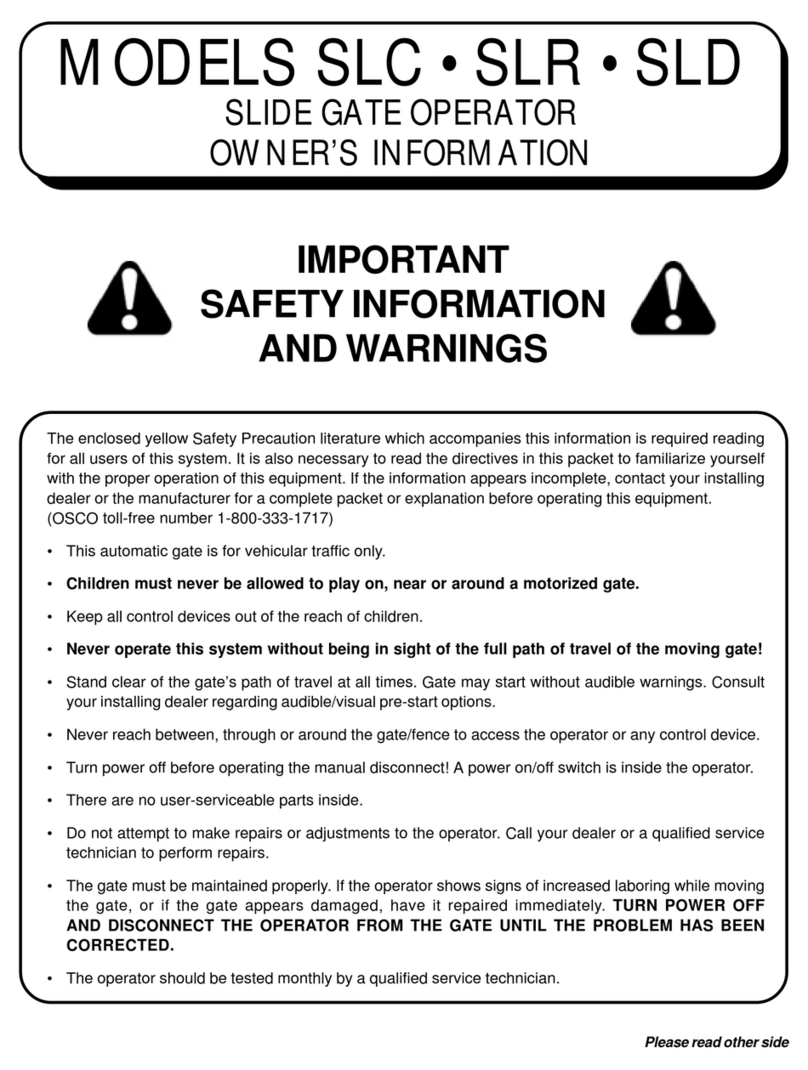
Linear
Linear SLC Technical manual
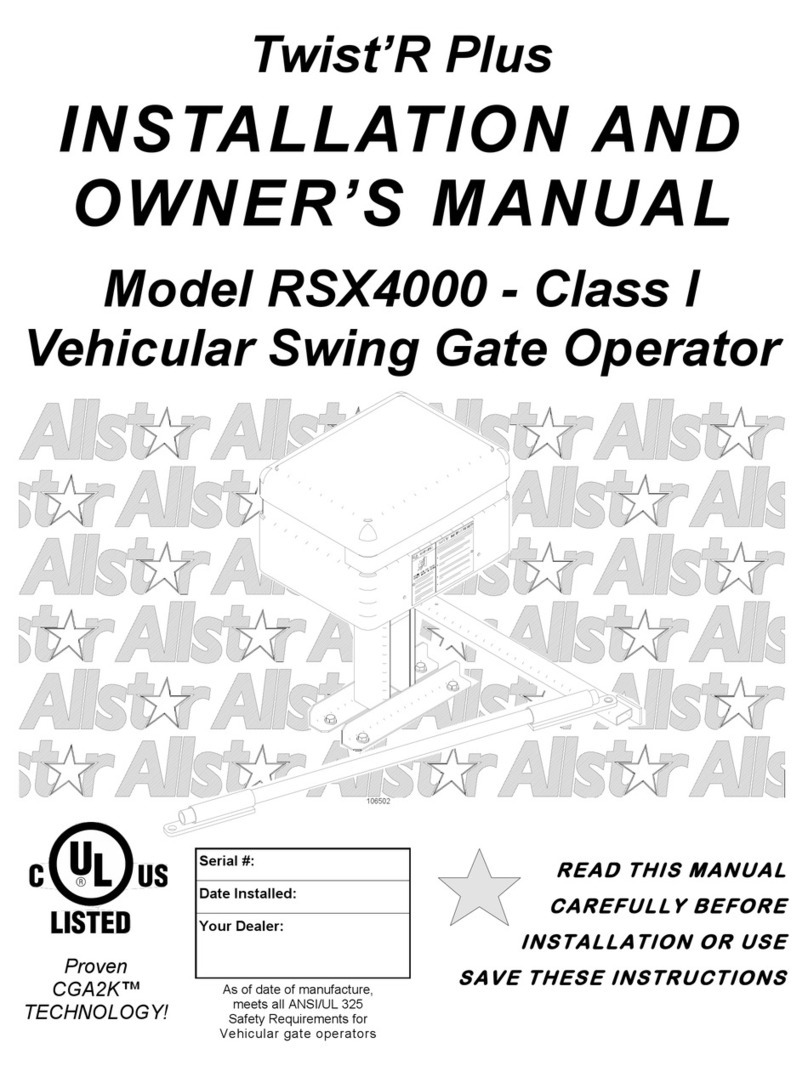
Linear
Linear Twist'R Plus SX4000 User manual
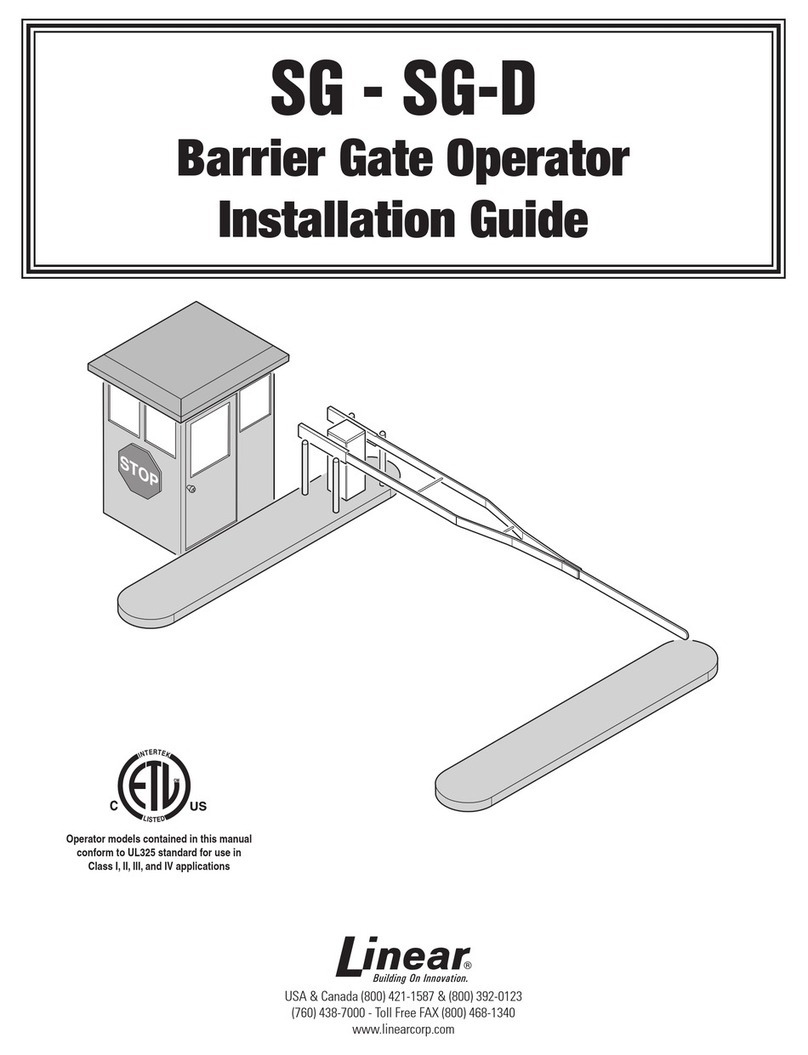
Linear
Linear SG User manual
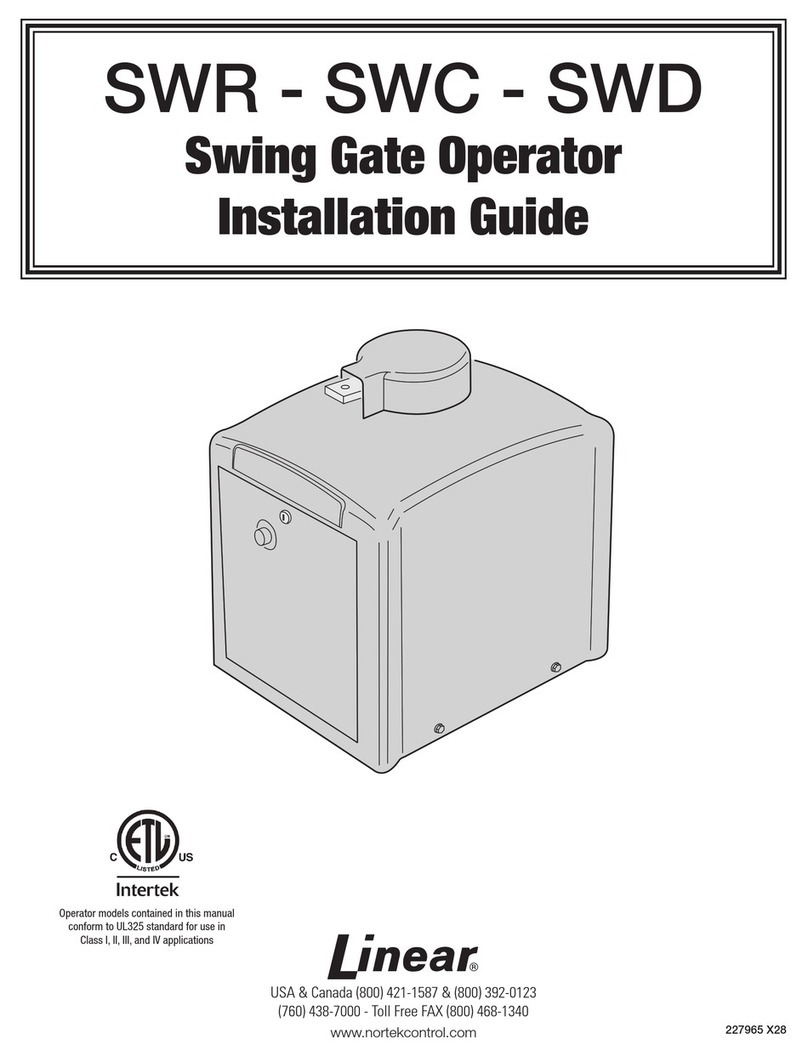
Linear
Linear SWR User manual
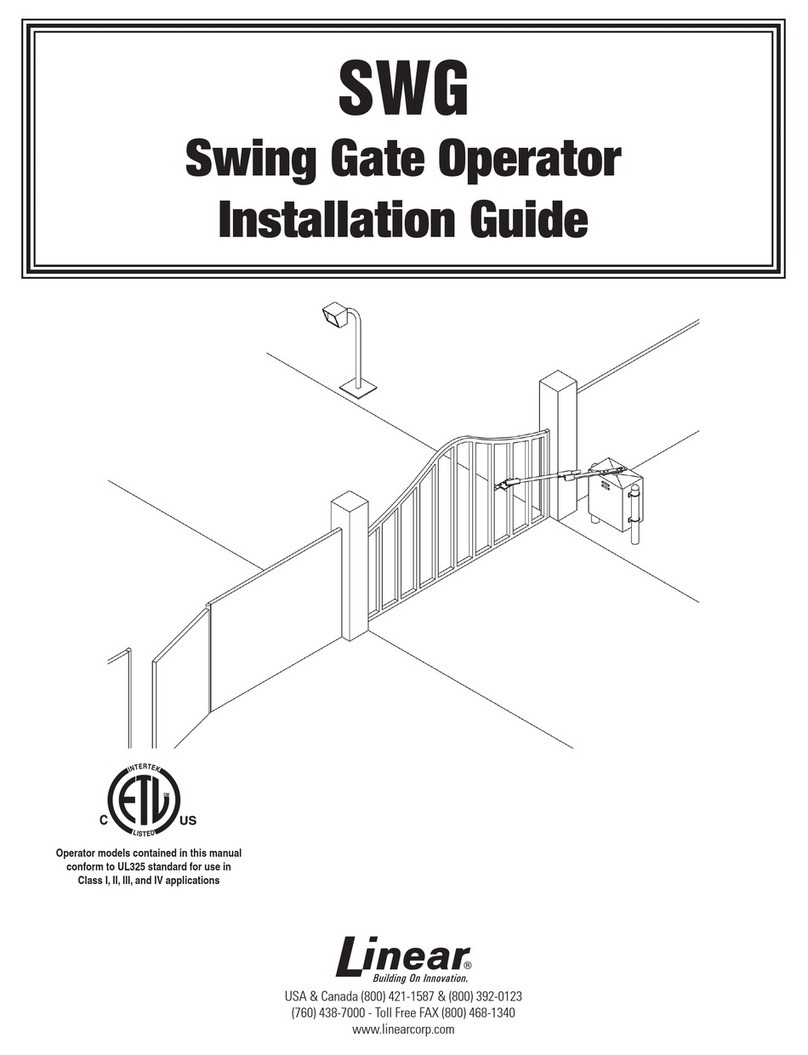
Linear
Linear SWG User manual

Linear
Linear SWC User manual
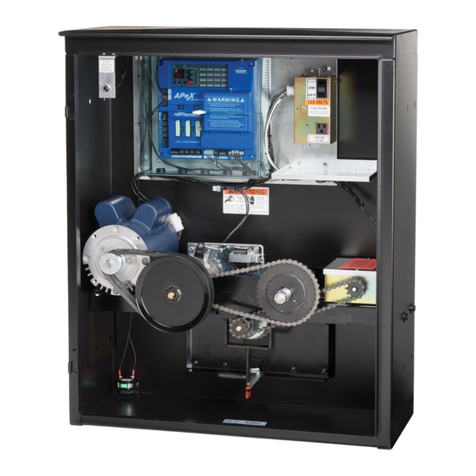
Linear
Linear HSLG User manual
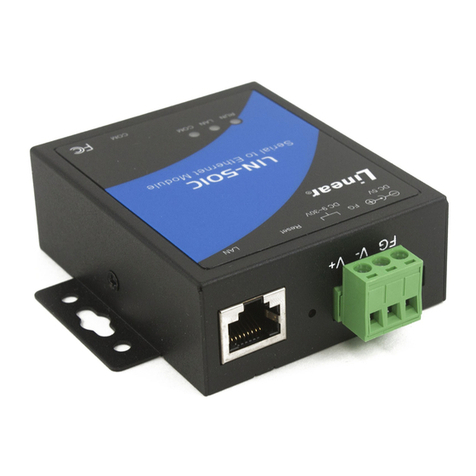
Linear
Linear AM-SEK User manual
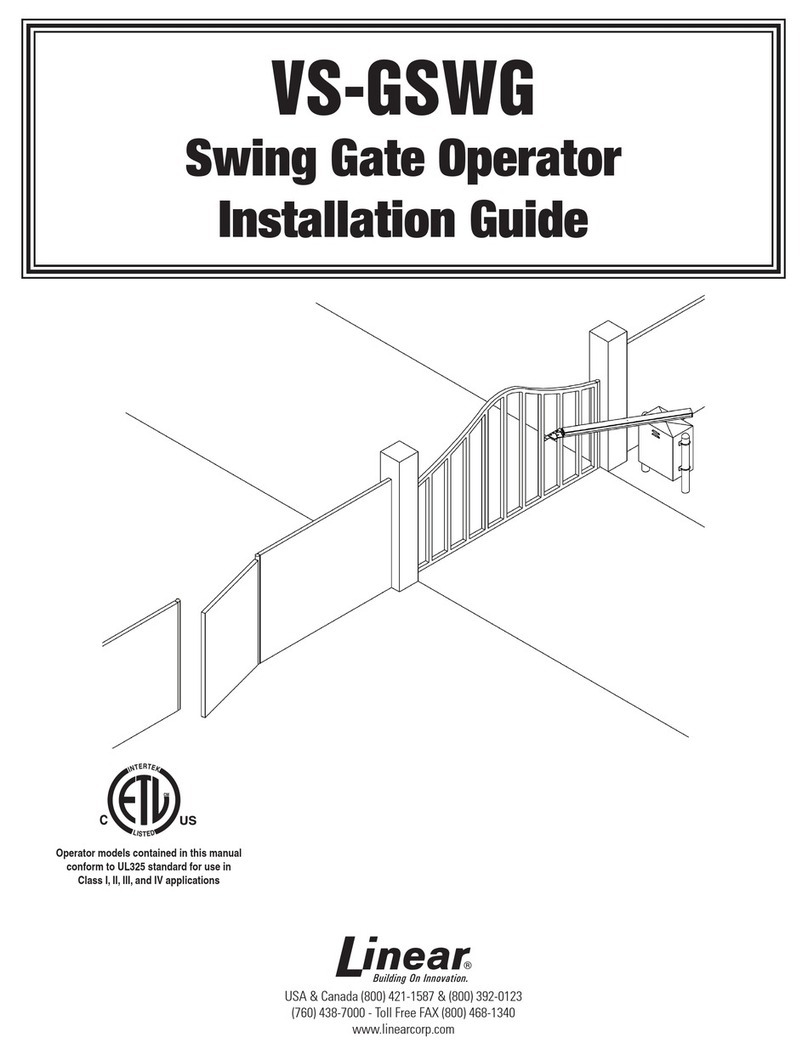
Linear
Linear VS-GSWG User manual

Linear
Linear HSLG User manual
